I currently share my life with two Siberian Huskies – puppy Lara (7 months old) and Shania (3.5 years old). Both of them are very silly, and very energetic. They love to play, explore, and hunt for earth critters.
Siberian Huskies are beautiful dogs who love people and love life. They can be great family dogs if properly trained. However, because of their high energy and high prey drive, they require a lot of daily exercise and are not to be trusted off leash. When bored, a Husky may chew, dig, and escape to look for adventure elsewhere.
Before getting a Sibe puppy, find out all you can about the wonderful nature of Siberian Huskies – the good, the bad, and the quirky.
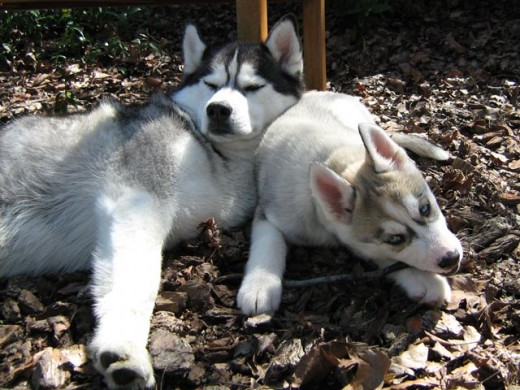
Siberian Huskies – The Good
1. Siberian Huskies are love bugs.
Sibes are very affectionate dogs. They are especially friendly with people, even strangers.
Husky Shania has very many friends in our neighborhood and she enjoys going to say hello to them every day. Her most favorite friend in the world is the Awesome Cookie Guy. Whenever we pass his house, Shania always stops and waits. When her Cookie friend spots her and comes out, he comes bearing gifts – a yummy low-fat cookie for Shania!
Shania also comes to me when I am sad or upset. She will lie down next to me or lay her head on my lap and give me licks.
The people trusting nature of Siberian Huskies make it easy to find caretakers for them when I get busy, or when I need to leave on emergencies or vacations.
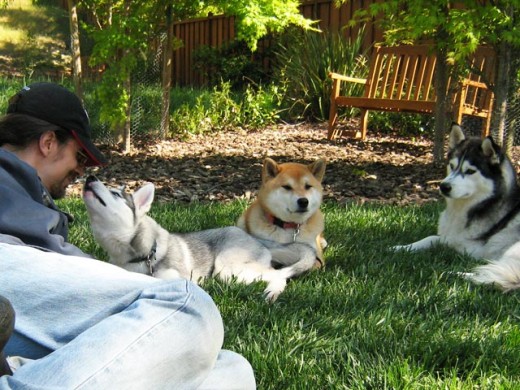
2. Siberian Huskies are athletic and have a strong zest for life.


Lara and Shania are frequently on the go. They enjoy re-landscaping our backyard, attacking bushes, pulling down trees, running, jumping, and digging. They both enjoy playing chasing games and are always ready to go out for a walk and explore. They get very excited whenever anybody comes to visit and enjoy spending play-time and rest-time with their pack.
As part of their zesty life program, Huskies also love to eat.
Both Lara and Shania will eat and eat and continue to eat more if they can. To keep them healthy and slim, I set up a fixed eating schedule and only give them their allotted amount of food. If I give them treats, then I reduce their regular meals a bit so that they keep a fairly constant caloric intake.
Sibes are not shy about stealing food or begging for food. Both Lara and Shania will steal each other’s food if they can. They will also steal from my other dog, Shiba Inu Sephy.
I always supervise them closely during meal-times. Food stealing can encourage food aggression, so I train my dogs not to steal and teach them that if there is any stealing, I will handle the situation.
Siberian Huskies can also get impatient about food and may get slightly overzealous when taking food out of your hand. Bite inhibition training is a must.
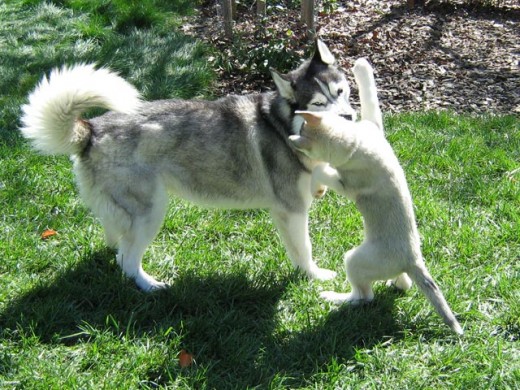
3. Siberian Huskies are clever and independent.
Reward Training
Sibes are smart and will quickly learn new commands and figure out interactive toy puzzles; especially when food is on the line.
Lara learned how to Sit on command as soon as we got her home (8 weeks old). In fact, if we use positive reinforcement techniques, we can start obedience training puppies as early as 6 weeks old. However, puppies should not be removed from the litter until they are at least 8 weeks old.
With clever and independent dogs like the Siberian Husky, it is most effective to use reward training techniques. I teach my Huskies that the best way to get what they want is to do what I want first. Here is more on how I trained my Husky puppy.

- If they want to go play in the backyard, they must first do a simple Sit next to the door.
- If they want their food toy, they must first do a Handshake.
- If they dig where they are not supposed to in the backyard then they lose their backyard privileges.
Since we control all of our dog’s resources, we can encourage good behaviors and discourage bad behaviors by tying those behaviors to our dog’s most desired resources.
With reward training my Sibes are always motivated to work. They are never hand-shy and love being with people. Siberian Huskies have a wonderful independent spirit, so we should not shock them, choke them, or physically dominate them into submission.

Siberian Huskies – The Bad
1. Siberian Huskies shed a whole lot.

Sibes blow their coat once or twice a year. During this time they will shed most of their undercoat and replace it with new fur. Frequent brushing will help to control some of this shedding and keep our Husky comfortable and clean.
Even though they may only blow their coat twice a year, Sibes actually shed all year round. There is Sibe fur everywhere in our house, including carpets, tile floor, counters, tables, chairs, blankets, and beds. Hair can also get onto kitchen utensils, food, and drinks.
Another issue to consider is pet allergies. Many people are allergic to dog or cat hair. Although Siberian Huskies have little doggy smell and are not one of the most allergy-causing breeds, a serious pet dander allergy of a family member should have you reconsidering a dog for your choice of pet.
~~[Siberian Husky Club of Canada]
Because they shed so much, try to make brushing and handling fun for your Husky. I always pair brushing sessions with food so that it becomes a fun and rewarding experience. I start with a soft brush and slowly switch over to using the Furminator which is awesome at getting out a dog’s undercoat.
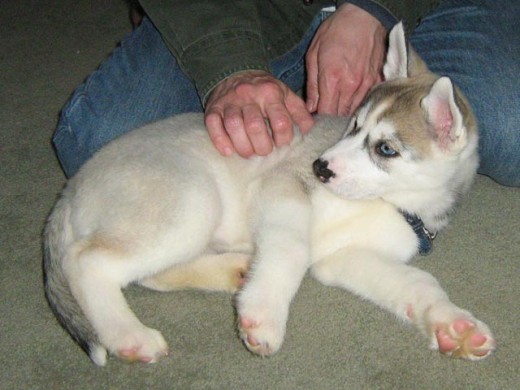
2. Siberian Huskies are awful guard dogs.

Sibes look wild, like wolves. For this reason, many people think that they make fierce guard dogs.
In truth, however, a Husky is more likely to invite strangers into your home with open paws and give them many licks.
Siberian Huskies are happy, goofy, and naturally trust all the people that they see.
My Siberians may sometimes make a fuss when people are at the door, but it is out of excitement rather than a warning cry.
Also, my Siberians will happily follow anyone home as long as they have some yummy pieces of food.

3. Siberian Huskies have very high prey drive.
Husky Shania is a very accomplished huntress.
When we first got our backyard landscaped, we had a big Earth Critter Attack. There are a fair number of rodents including gophers, voles, and mice that live in our area and they decided to throw a big party on our newly planted grass. Holes were appearing everywhere and the organic scent-based pest control we used did not seem to have much of an effect.
We were worried that our yard would not even last the year but then huntress Shania went into action. After a few days of hunting and marking, we noticed that the Rodent Gang had moved their party location somewhere else!
However, this high prey drive also makes it extremely risky to let a Sibe go off-leash in a non-enclosed space. If she spots a deer or squirrel, she will be gone and away before you can shout Stop. Siberian Huskies are very athletic and can cover large distances in a fairly short amount of time.
High prey drive also means that a Husky will have a strong instinct to chase and hunt cats and possibly also small dogs.

4. Siberian Huskies love to pull, pull, pull.


Sibes were bred to pull sleds, and today, they still love to PULL!
One of the biggest challenge with my Huskies is teaching them how to walk without pulling and/or to only pull on command.
The easiest way to leash train a Husky, is to start when she is young and still small. I have tried a variety of techniques with my dogs and what has worked best are the red-light,green-light technique and the 180-turn-around technique.
I started leash training puppy Lara almost as soon as we got her. First I trained her in our backyard. After she was fully vaccinated, I started leash training her around our neighborhood.
While leash training a Sibe, it is very important to be totally consistent. I stop as soon as puppy Lara starts to pull and if she pulls too much, I turn around and walk in the opposite direction. This teaches her that the fastest way to get to where she wants to go is to walk along with me at a measured pace.

5. Siberian Huskies love to sing.
Sibes have a great singing voice. However, neighbors may not particularly enjoy it when Siberians decide to sing or howl to the moon.
Husky Lara is a very vocal dog. She barks when excited, frustrated, scared, and sometimes when other dogs are barking. I have to spend more time and effort training her to stay quiet because her natural instinct is to vocalize.
Husky Shania is a more quiet dog. She almost never barks and the only time she vocalizes is when she is playing with my other dogs. She also sings beautifully when she hears a squeaky toy.
My Husky breeder tells me that there are some Sibe bloodlines that are more noisy than others. Lara’s mother, for example, comes from a more vocal bloodline.

6. Siberian Huskies are a big time commitment.

Sibes are very energetic and affectionate. They like being with people and they also need something to do. Otherwise, they will get bored and get into at least 10 kinds of trouble.
All my dogs work for all of their food, either through obedience exercises, grooming sessions, play sessions, or through interactive food toys. In addition, they go for 1.5 hour daily walks and wrestle with each other several times a day. Sometimes, I join in on the fun and play flirt pole or the water hose game with them.
When bored or lonely, a Husky will figure out her own activities, which may lead to property damage or escape expeditions.
Do not get a dog, especially a Siberian Husky, unless you have a lot of free time to spend with her. If you must work long hours, consider dog daycare or hiring a dog walker. Sibes do best when there are many interesting activities throughout the day and frequent human supervision.

I Love Siberian Huskies
Sibes are awesome dogs. They are always ready of adventure, and they will be there to give you licks and support when you need it, or even when you don’t.
I got my Huskies through the breeder list from the Siberian Husky Club of America. I also considered adopting from my local Siberian Husky rescue, but did not find one that fit well with my Shiba Inu.
It is best to avoid backyard breeders, pet stores, and online pet stores. Such establishments almost always sell unhealthy puppies with poor temperaments.
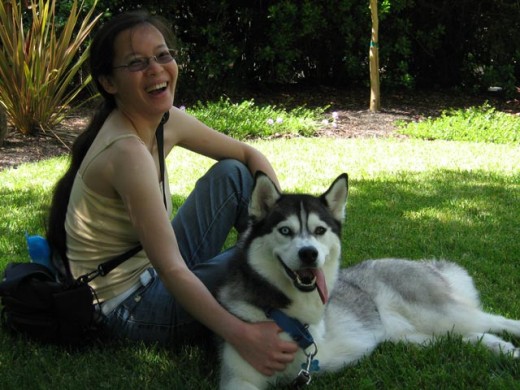
Source: Siberian Husky Pictures.
Really like the halters we have for our 2 Sibes. Wonder Walker out of Seattle, WA. They have lot of Sibes in that area. Has ring on back of neck and on breastbone in front. They suggest using one in front. Seems to make walking easier. Wonder Walker. Google it. Hope this helps.
What is red light, green light technique for walking a husky that pulls.
I plan to use it with the 180 degree turn-around drill with my two.
Frank
One point on dog food. I use Nature’s Domain in the light blue sack from Costco. Salmon and sweet potato. No grains in it. Add a spooonful of pumpkin for ruffage (no spice kind, just natural) and a capsule of fish oil. Seems to work okay for my 2 sibes.
http://shibashake.com/dog/leash-training-your-dog#red-light
I copied everythingn you gave me. Quite a pile with comments. I have 60 ft. deck where most of training will go on. Also in my opinion there are too many dog training books. They don’t break it down to small segments.
Too much time spent on things that don’t matter: roll over, shake hands, and other mundane things for dogs to do. Only about 6 main
things that dog need to learn (maybe 8) for an obedient dog.
Most dogs are not well trained. Owners need guidance. They want to do right thing.
Hello there,
Came into your website as I was researching for dog food and I felt compelled to write in.
I like your website and the manga/anime-like of husky displayed at the the top and bottom of each page – nicely done! Your website is clean and easy on the eye that made me feel like there is a “breath of fresh air” when I first entered and that I can read each article at a calm state of mind. Thumbs up 🙂
Your Siberian Husky and Shiba Inu are very good looking and what can i say but love them at first sight. Please send my big hugs to them.
Awesome 🙂
Wish you and your family well.
Best Regards
Sara and Harley (my pet husky)
Thank you very much for your wonderful comment Sara. It is greatly appreciated. 😀
Big hugs to Harley!
I need help my husky loves to tear up my carpet inhis attempts to escape its gotten so bad he has made a hole in my floor anyway to stop it? I cant crate him as hes destroyed two creats trying to get out which he usually succeeds. I also cant get him to stop stealing food and eating out the trash no matter how much he eats. Also have a kitten and he seems to be playing but then bites it idk if he plans on hurting it or not I really need advice I love my dog very much as does my child and I doubt ill ever find a breed so good with her but imloosing options
How old is he? How long have you had him? What sort of training has he had? What is his daily routine like? How much exercise does he get? Does he worry at the carpets or try to get out of his crate only when he is alone?
In terms of stealing food, that is a self-reinforcing behavior. If a dog tries to steal food, and then succeeds, he gets rewarded for the “stealing” behavior with food. This reinforces the stealing, which encourages the dog to keep repeating it more often. To stop counter surfing and other types of stealing behavior, I make sure that my dog never gets rewarded for the behavior (i.e. he never succeeds in getting anything).
– When there is food on tables or counters, I make sure to be there to supervise and prevent stealing.
– When I cannot supervise, I make sure there is no food to be had. I keep my trash within a cabinet and I put food away where my dog can’t get to it.
As for cats, here is an article from the ASPCA on introducing a cat to a new dog.
http://www.aspca.org/pet-care/virtual-pet-behaviorist/cat-behavior/introducing-your-cat-new-dog
Subject: 3 legged dogs
We deal with a Siberian rescue facility in Dayton,
WA. At different times there were 3 legged dogs there. Most of the time I did not even notice they were 3 legged. I always thought it would be advantageous to line up these dogs with amputee vets from Afgan and Iraq
wars. I don’t thing anything ever came of it. Just a thought. I wouldn’t mind having a 3 legged Siberian.
Yeah, that happens a lot with Shania. Most of the time, people don’t even notice because she is such a go-go girl, and is taking me for a walk.
That is a good idea. I think 3 legged dogs can help in a broad range of circumstances because they handle adversity so well. Being a Sibe, Shania often leaps first and looks later, so I have to do the worrying for her. 😀
We have 2 Siberians(from rescue). 1 1/2 to 2; male and female.
They love to play fight. We call it Kung Fu fighting. Read article in dog magazine that this was natural.
We let them do it at home. Also involves pull toys. They get along
very well. I am wondering what carry-over is this dog parks.
Need Pros and Cons.
The dogs get along very well.
With dog parks it depends a lot on the people and dogs who frequent the park.
Some of my dog park experiences.
All my dogs like rough type play with lots of wrestling, so they do better in smaller, more structured play groups. I supervise and carefully pick their playmates so that everyone has compatible play-styles and everyone enjoys the session.
Here is 1 example of dog parks. I call it the dog park from hell.
It is in AZ at a campground. Most of owners are seniors. They use it as a time to visit and don’t watch dogs. Most of their dogs are old (fragile). Almost all the dogs are also 8 inches long. Sibes’ prey instincts and fact that most of dogs look like rats do not go together. At least it doesn’t have my other peave about parks: super small kids. Most of trouble starts at entry gate. I try to keep my dogs away from entry ritual. How do I cope? I go at off times when there are no dogs or large dogs. My 2 dogs can entertain themselves and know how to run on their own. Dog parks require a lot of work by owner to be a successful experience.
Yeah, I agree. For all these reasons and more, I no longer take my dogs to enclosed parks. They do much better in smaller play-groups that are much more structured.
The parks that I went to had rules about not bringing kids, but still people brought them. They also had separate areas for small dogs and big dogs, but people often bring their small dogs into the big dog area because that was where most of the people were. In the end, it worked out much better for me and my furry gang to organize play groups at home with friendly neighborhood dogs.
Hello,
I am emailing wondering if anyone has had any issues with there siberian husky peeing in cage. We have a almost 7th month old siberian we have had since she was 8 weeks old. She has been house trained for a couple months now. She was spayed three weeks ago and every since she has started to pee in the back room where her cage is and is peeing in her cage no matter how long she is in it. She is always let out before being put in the cage. The Vet checked her urine and found no issues but still gave her an antibiotic. Does anyone have any tips or ideas on why she would be doing this? She lays right in her pee and doesnt care.
Let me point out she is an indoor husky puppy and she only is in her cage during the day while were at work. At night she sleeps with us. (bad habit was started by husband)
Is she also peeing more often? Is she only peeing in the cage, or are there mistakes elsewhere as well? Does she only pee in the house when she is alone? How long is she usually in the cage?
Is she alone in the backroom? Was the cage always in the backroom? Was she ok being in the cage before the spay surgery? Has anything else changed since the spay surgery – either with her behavior, routine, or surroundings? Has she shown any improvement after the antibiotics?
This thread has a discussion on more frequent urination after spay-
http://www.dogforums.com/dog-health-questions/12353-frequent-urination-after-spay.html
Our 2 Sibes have run of house. Usually our mistake when they pee in house. You get so you are a real good judge of body language when they have to go outside. I always try to mentally keep track of how long it has been since they went out. Good luck.
hello,
I am a soon to be husky puppy owner. I am in the works of adopting a 12 week old husky however i will not be able to welcome him into my home until he is 14 weeks. Something i am truly concerned about is loosing that initial 6 weeks with the puppy. How big is he going to be at 14 weeks? am i missing out with those 6 weeks? both for the experience and the training advantage as well?
Thanks!
Congratulations on your upcoming Husky puppy!
Here is a picture gallery of my Husky Lara at 15 weeks-
http://shibashake.com/dog/shiba-pictures/siberian-husky-puppy-15-weeks
A picture log of Lara from 5 weeks to around 12 weeks.
http://shibashake.com/dog/siberian-husky-puppy-pictures-first-3-months
Both my Huskies are affectionate and very food focused, so training was not very difficult after I familiarized myself with the basics of dog behavior. What is the puppy’s current situation? Is he currently being fostered in a home? What is his history?
More on how I trained my Husky puppy.
Hi,
My Serbian Husky is 4months old today. She has been crate trained since the day we got her and is very comfortable bing in the crate as of a night.
The crate is in our bedroom as to give her that bit of security that her pack is close. She is house trained, sits and taps on the door as and when she needs to go out to the bathroom. Our before bed routine is to go outside to the toilet and then straight into the crate where I give her a little treat.
Almost every night, around 1-2am, she starts to cry and tap on the cage door because she needs the bathroom. She goes straight outside, goes to the toilet, has a sniff around and comes straight back in to her cage. No problems at all.
I feel that this has started to become a habit more than anything else. Is there anything I can do to brake this habit? or does she really need to go out? Or is she bored and just wants to go out and play?
There are some nights when she will go the entire night without wanting to go out. This is usually after we have been for an extra long walk and she is completely shattered, but not always.
She goes into her bed around 10pm and out again in the morning between 6:30-7am. On a good night she will last all that time. But most, she wants to go out at about 1-2am.
Looking forward to hearing your thoughts!
Take care.
One thing that I do with my puppy is to limit water intake right before bed. I stop giving my puppy water about 2 hours before bedtime, but I make sure she drinks a bunch on last call. Then, as you describe, I let her go out to do her stuff right before bed. If I need to give her treats before bed, I give her wet stuff such as little pieces of boiled chicken. I don’t give her dried biscuits or anything else that may make her thirsty. If she is thirsty, I give her an ice cube, which helps with teething and also limits the amount of water intake.
It is difficult to say without seeing the dog and her surrounding context. Purely from your description, it sounds (to me) more like she needs to go. Since she actually does her business and then goes straight back into her crate, there doesn’t seem to be much opportunity for play.
When my dog is angling for outside time, he doesn’t pee right away or he may not pee at all. Instead he wants to spend most of the time exploring, and then does not really want to go back inside. 😀
Congratulations on your new Sibe! She sounds like a really wonderful pup. Do you have any pictures of her online? I would love to see her.
Yeah i have a snake and was going to put a mouse for it and the mouse jumped on the floor and my husky grabbed it to quick for me to catch it. ran away and i couldnt get it away from him. hes about 23 months old… is this going to be bad for him or do i have little to worry about
So far, the worst thing that has happened to my Husky from eating outside mice is tapeworms. However, that is from the fleas on the mice – so it shouldn’t be an issue with indoor mice.